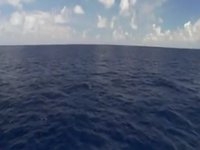Mystery of French submarine disasters can never be unveiled
The death, or rather, sudden disappearance of Eridis submarine of the French fleet stirred heated debate in the world. The tragedy occurred early in the morning on March 4, 1970. Despite the fact that the site of the tragedy was found almost immediately, it took specialists almost two months to find the submarine itself. This is not the only mysterious detail about the disaster.

Generally, there is very little information about French submarine Eridis. In contrast, dozens of books have been written and several documentaries have been made about the death of Russia's Kursk submarine. A well-known documentary on the Kursk disaster was filmed by famous French journalist Jean-Michel Carre. The reason and basis for the film, as the author of the film admits, was the article published on the Pravda.Ru website three years after the death of the Kursk.
During the International Film Festival of marine and adventure films "The Sea is Calling," which takes place in St. Petersburg, the author of this article had a chance to talk to the former commander of France's third nuclear submarine, Rear Admiral Jean-Marie Mate. The admiral did not reveal any special secrets about the Eridis other than those that can be found in the open press, albeit in limited quantities. Jean-Marie Mate pointed out that submariners, whatever their nationality might be, always remain heroes. Figuratively speaking, they have only one nationality that is directly connected with their profession that is equally difficult and dangerous in all navies of the world.
But still, why did the death of Eridis submarine receive so little attention in the press, books and movies? The disappearance and death of this submarine in the Mediterranean Sea used to be a worldwide sensation ... The secret of secrets. However, we managed to find some information on the subject. We had to resort to the help of translators from French and dig into into the archives of the Russian, or more precisely, Soviet Navy (the Russian military also investigated the disaster). Here's what we found out.
The Eridis submarine belonged to the Daphne class of diesel-electric submarines. There were eleven submarines of this type built for the French Navy, and all of them were named after mythical goddesses, nymphs and dryads. Submarines of this class were built for the navies as Spain, Portugal, South Africa and Pakistan. The full water displacement of the submarine made up a little more than a thousand tons. It was about 58 meters long and was outfitted with 12 torpedo tubes (which was a bit more than any Russian submarine of the class had).
According to historical information that can be found in Russian sources, the construction of submarine S-644 Eurydice began in July 1958 at Direction des Constructions et Armes Navales shipyard in Cherbourg. The sub was launched on June 19, 1960, and on September 26, 1964 the submarine was passed into service. Its service was common for French submarines: combat training of the crew, patrolling the southern coast of France and North Africa and escorting civilian vessels with important goods. The Eridis has never traveled outside the waters of the Mediterranean Sea.
Early in the morning of March 4, 1970, the Eridis left the base of Saint-Tropez. There were 57 people on board. At sea, the submarine, in cooperation with aviation, was supposed to exercise the search and conventional attack against a submarine of a potential enemy. For this purpose, the Eridis was in touch with the basic patrol plane Atlantic that took off from Nimes-Garon naval air base. The sea seemed to be calm at first. Interestingly, pilots saw the periscope breaker of the Eridis when the sub was about seven miles to the south-east off Cape Camara. Communication was normal. Suddenly, early in the morning, at 7.13 a.m. local time, messages from the Eridis ceased to arrive. The Atlantic aircraft lost the radar contact with the submarine ...
In his last radio message, the submarine commander said that he was taking the course in the area of the exercise and was preparing to submerge. Very quickly, almost immediately after the break of connection, naval aircraft and anti-submarine vessels began to look for the lost vessel. The French navy sent everything that was available into the sea: surface ships Surcouf, Dyuper, Picard, Vendée, Alert, Arago, Jean Charcot, six minesweepers, Daphne and Doris submarines, as well as airplanes and helicopters. The Italians and Americans also took part in the search: they sent four minesweepers and the Skylark rescue boat.
The approximate area of the death of Eridis was found quickly. The place, where patrol aircraft Atlantic saw the submarine during the last session, was found as well. A large spot of diesel fuel, pieces of plywood and a punch card with the name "Eridis" were found some time later. The remains of the submarine proved that the submarine had sunk. Experts began to investigate the disappearance of the submarine. They analyzed samples of the diesel fuel that was found on the water surface. The analysis showed that the fuel had a high content of sulfur, which was characteristic of the fuel of the lost submarine.
Four days after the start of the search, the administration of the French Navy announced the Eridis and 57 members of its crew perished. Officers on rescue ships removed their caps, and all ships of the French fleet blared their horns in memory of the victims.
Some time later, after analyzing the data of seismographs of coastal surveying laboratories, it was found that there was an explosion recorded on March 4th, at 7.28 a.m.. The place, where the tragedy occurred, was found quickly. However, it took specialists quite a while to find the submarine itself.
The relatives of the dead sailors demanded the submarine be found at all costs and the cause of its death be established. The French government asked the United States to assist in the search for Eridis. American rescue ship Mizar arrived in Toulon: the vessel successfully demonstrated her abilities during the search for the Thresher submarine. It was only on April 22, more than 1.5 months after the death of the submarine, when the Americans detected and identified several large fragments of Eridis scattered at depths from 600 to 1,100 meters ...
It was later found that a large fragment of the stern of the Eridis was resting in the center of a strange crater that was 30 meters in diameter. All metal fragments of the sub were strangely twisted and deformed. European newspapers started guessing. Design flaws? Crew error? The version about alien intervention was especially popular during that time. Some suggested that the Eridis collided with a merchant vessel. Indeed, Tunisian, Argentine and Greek cargo ships traveled across the area, where the accident occurred.
The results of the investigation have never been exposed to the general public. The death of the Eridis caused national shock in France. A few years before, three French submarines sank with their crews near Toulon, one after another. On December 6, 1946, U-2326 submarine tragically sank (France received the submarine after the defeat of Nazi Germany). On September 23, 1952, submarine Sibylle was lost (former British R.229 Sportsman). January 27, 1968 became the day when France lost Minerve sub (of the same type with Eridis).
The reasons of those disasters remain a mystery. Is there a Bermuda Triangle in the Mediterranean Sea?
In Toulon, at one of the main bases of the French Navy, a monument to the dead submariners was erected. The French still go there to honor the memory of the dead submariners.
Andrei Mikhailov
Pravda.Ru
Subscribe to Pravda.Ru Telegram channel, Facebook, RSS!




